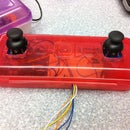Introduction: Arduino Drawbot
Step 1: Materials
The following will be divided in categories and in no particular order:
Tools:
1. Drill with a drill bit (size depends on the diameter of the marker)
2. Screwdriver to attach the wheels to the servos.
Hardware:
1. (X2) spray paint can caps.
2. (X2) small screws
3. (X3) rubber bands
4. Piece of wood ( size, shape and thickness could be any to fit all the parts)
5. Arduino UNO Rev3
6. Breadboard
7. (9V) battery
8. (9V) connection harness to provide power to the Arduino.
9. (X4) wires for all the connections.
10. A marker ( any color)
11. (X2) Parallax Servos with the 360º MOD
12. 12 pin connector
13. USB cable to prgram the Arduino.
14. Something to add traction to the wheels ( I have use from lego, two rubber tires, but you can use any electrical tape also).
Software:
Arduino software (to upload the code)
Step 2: Step 1
Cut a piece of wood. Mine is 8 inches long. Then drill a hole in one of the sides ( I was drilling and measuring with the marker so it could fit in the hole. But the key is not to make the hole too big so the marker would'nt be loose as you see on the picture. If is loose in the hole the just add a piece of tape around it to make the marker more thick for the hole).
The piece of wood I am using is a 2'' wide by 1/4'' of thickness.
You can use whatever you got (plastic, metal or even a good piece of cardboard)
Step 3: Step1 (Bread Board)
Use the rubberband to hold the breadboard in place as you see on the picture.
Step 4: Step 3 (Arduino)
And again use the rubberband for the Arduino as well.
Step 5: Step 4 (Servos)
Attach the two servos to the base (wood piece).
Also it is a good practice to write in the back of the base the letters L and R to make the final connections of the servos easy. ;)
Step 6: Step 5 (Wheels)
Attach the caps to the servo arm with two screws. And the one in the middle attach it to the servo.
You don't need to drill a hole here, the plastic is thin for the screws to go through.
Then add the traction to the caps, it could be electrical tape. ( I have use rubber tires from a lego)
Step 7: Step 6 (First Connection)
The following connection is to provide power to the servos.
Notice that I have use a 12 pin connector to connect the servosto the breadboard.
ORANGE = 5V
YELLOW = GND
Step 8: Step 7 (Second Connection)
First: Connect the 5V connection from the Arduino to the breadboard.
Second: Connect the GND connection from the Arduino to the breadboard.
NOTE: (BreadBoard Basics)
When you make a connection from the Arduino to the breadboard it will provide either power or a Pin function connection to the whole row.
Step 9: Step 8 (Third Connection)
First: Connect the pin 9 from the Arduino to the breadboard for the Left Servo and that is the white cable connection of the servo.
Second: Connect the pin 10 from the Arduino to the breadboard for the Right Servo and that is the white cable connection of the servo
Look at the pictures to have a clear understanding on how the connections go.
Step 10: Step 9 (Fourth Connection)
Connect the servos to the breadboard.
Make sure the white cable connection on the servo is were the pins to the Arduino are.
Almost done... DOUBLE CHECK THE CONNECTIONS!!! ;)
As you see on the second picture I have run the cables under the Drawbot to make everything clean and organized. ;)
Step 11: Step 11 (Programing)
Here is the code for our Drawbot.
The code was found on the internet and I have use it and it is working.
AWAYS COMPILE the code before uploading it to the Arduino ;)
CODE:
/*
* 5 Minute Drawbot.pde
*/
int servoPinL = 9;
int servoPinR = 10;
void setup() {
pinMode(servoPinL,OUTPUT);
pinMode(servoPinR,OUTPUT);
}
void loop() {
digitalWrite(servoPinL,HIGH);
digitalWrite(servoPinR,HIGH);
delayMicroseconds(1500);
digitalWrite(servoPinL,LOW);
digitalWrite(servoPinR,LOW);
delay(50);
}
Step 12: Step 12 (Power)
Not much to say here just attach the 9V battery to the DrawBot and connect it to the Arduino.
Watch it making circles, as you can change the markers to make different circles in different colors.
I have use a sharpie but I rather use a washable one in case of an accident.
ENJOY your first ARDUINO BOT ;)
Step 13: Troubleshooting
1. The marker is loose and the hole is too big.
A. Put some tape arround the marker to make it fit.
2. What else can I use as wheels?
A. There is a lot of stuff to use an example is tupperware tops or lids.
3. The servos wont move.
A. Make sure all the connections are not loose double check them.
A. Also make sure the 9V batterty is new this servos will drain all its power.
4. When connected to the power I have check all connections still servos wont move.
A. Double check that you upload the code to the Arduino, and when connected to the power you don't see servos move a little
it means that there is no code running in the Arduino.
NOTE:
When the power is connected if you dont see any light on the Arduino that means the battery does not have any power.
Any help needed let me know I will be glad to help all of you.
ENJOY ;)

Participated in the
Robot Challenge













